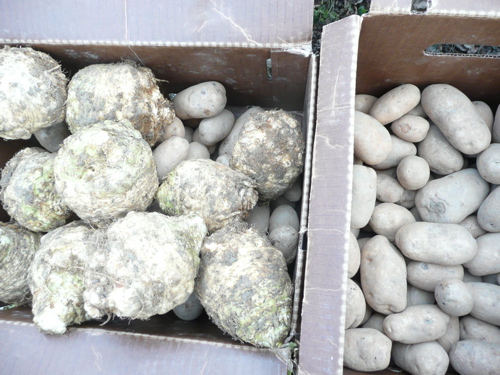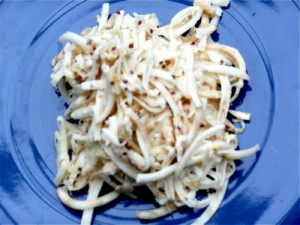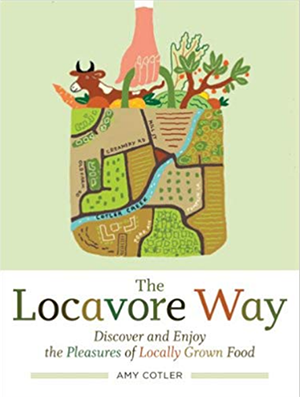
Boxes of local celery root and potatoes. I gathered up 4 households to split cases.
What’s new?
I’m gabbing on the Berkshire Food Journal
Winter farmers market Visit me at the Williamstown Holiday Farmers Market to say hello, pick up fabulous farm fresh food and locally crafted gifts, along with a signed copy of The Locavore Way. Winter markets support local farms while providing more access to fresh local food during the dormant season. And they bring everyone out, creating a warm community feeling. Find one of the 900 winter farmers markets near you. (The nearest to me is in Great Barrington.)
Winter cooking classes with local foods My new winter cooking classes, or solo culinary coaching make a great holiday locavore gifts.
The Recipe
After trekking down to Farm at Miller’s Crossing to pick up goodies from their end-of-the-seasons CSA sale, I’m knee deep in roots. So roots it is, starting with the under appreciated celery root, also called celeriac.
Celery root is the wallflower of winter root vegetables, stuck in the corner while all the rest boogie into America’s kitchens. No wonder, it’s a homely root with a warty skin that belies its fabulous flavor. Peel it with a knife and take a whiff. It has a celery-like aroma, but with an earthy edge that isn’t starchy, like a potato, but brighter with a hint of the exotic.
This tangy version of a classic celeriac remoulade disappears fast in our house, which is a good thing considering we bought nine pounds. Serve it as a side salad or in a sandwich or wrap. It makes a nice addition to a composed salad of other winter vegetables, each dressed differently, not tossed together but astride on the plate. It makes a great winter staple that goes nicely with apples added too.
The truth: I’ve given you fine proportions here, but all each celery root is a different size, and once you buy one you might as well use the whole thing, so simply mix the ingredients to taste. If you want a sharper flavor, add more vinegar, spicier, add mustard, creamier, add more mayonnaise.
1 pound celery root
2 tablespoons red wine or cider vinegar
3 or more tablespoons mayoinaisse, homemade or store bought
1 tablespoon whole grain mustard
1 garlic clove, minced
Salt to taste
1-Peel the celery root well with a paring knife, then grate it in a food processor.
2-Immediately toss very well with the vinegar, to prevent browning. Toss again with the remaining ingredients to thoroughly combine. (This stores well.)
Variations: A Gentler Root: Some folks like to cook celery root briefly to soften it a bit and remove its raw edge. To do so, just plunge the grated celery root into rapidly boiling water then immediately drain. Rinse with cold water until it is very cold and shake dry. Lemony: You can substitute lemon juice for vinegar, using whatever quantity you like. No Mayo?: My sisters and my pal, Judy, hate mayo with a passion, so this is for you. Omit it and simply dress the celery root to coat with a simple bought or homemade dressing of oil, vinegar or lemon juice, garlic, mustard and salt.
Making your own mayo?
All organic eggs are not alike. Buy sustainably raised or organic eggs from your local small-scale farmer. Organic agribusiness pushes the envelop as ever...
 The local and sustainable food movement in Africa? My interest in Africa was heightened by the highly visible African delegates at Terra Madre, Slow Food’s International conference, where I was a US delegate. (Their bright traditional garb put us all to shame with our drab duds.) Read about a reemergence of interest in Africa’s indigenous foods and Slow Food’s work in Africa.
The local and sustainable food movement in Africa? My interest in Africa was heightened by the highly visible African delegates at Terra Madre, Slow Food’s International conference, where I was a US delegate. (Their bright traditional garb put us all to shame with our drab duds.) Read about a reemergence of interest in Africa’s indigenous foods and Slow Food’s work in Africa.
More African delegates at Terra Madre








Posts like this bgrhtien up my day. Thanks for taking the time.